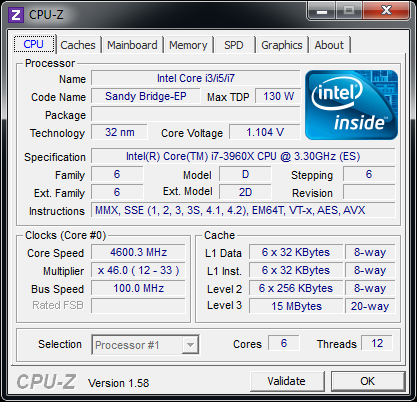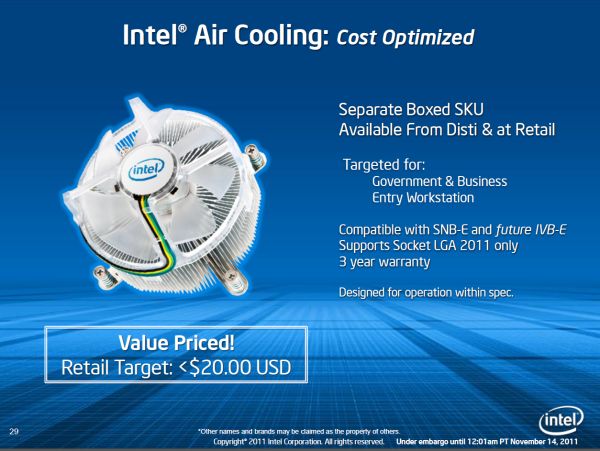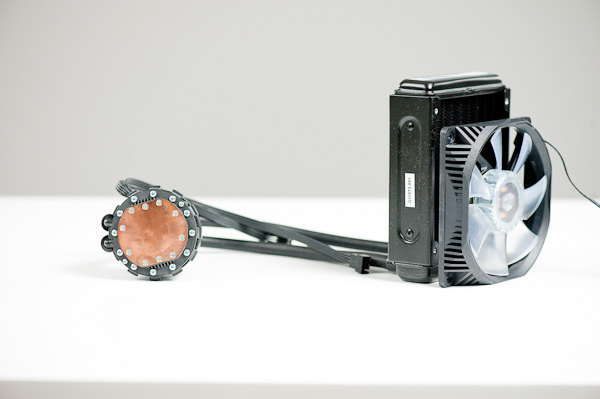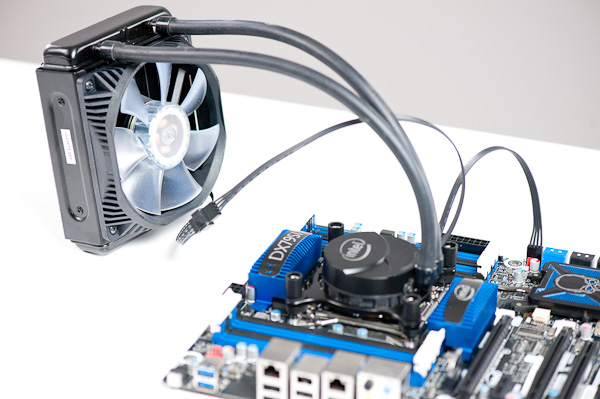Intel Core i7 3960X (Sandy Bridge E) Review: Keeping the High End Alive
by Anand Lal Shimpi on November 14, 2011 3:01 AM EST- Posted in
- CPUs
- Intel
- Core i7
- Sandy Bridge
- Sandy Bridge E
Overclocking
Sandy Bridge brought the motherboard's clock generator onto the 6-series chipset die. In doing so, Intel also locked its operation to 100MHz. While there was a bit of wiggle room, when combined with a locked processor, Intel effectively killed overclocking with most lower end Sandy Bridge chips.
For its more expensive CPUs, Intel offered either partially or fully unlocked (K-series) CPUs. The bus clock was still fixed at 100MHz, but you could overclock your processor by increasing its clock multiplier just like you could in the early days of overclocking.
With Sandy Bridge E, overclocking changes a bit. The clock generator is still mostly impervious to significant bus clock changes, however you're now able to send a multiple of its frequency to the CPU if you so desire. The options available are 100MHz, 125MHz, 166MHz and 250MHz.
Once again, wiggle room at any of these frequencies is limited so don't think we've moved back to the days of bus overclocking. You do get a little more flexibility, particularly with partially unlocked CPUs, but otherwise SNB-E overclocking is hardly any different from its predecessor.
Note that even if you select any of these options, the rest of the system still operates within spec. The multiplied bus clock is only fed to the CPU.

With a bit of effort I had no problems hitting 4.6GHz on my Core i7 3960X review sample. I had to increase core voltage from 1.104V to 1.44V, but the system was stable. While I could get into Windows at 4.8GHz and run a few benchmarks, the system wasn't completely stable.
No Cooler Included
None of the retail or OEM SNB-E parts include an Intel cooler in the bundle, a significant departure from previous CPUs. Presumably the cost of bundling a beefy cooler with these parts would've driven prices higher than Intel would've liked (remember you are getting a much larger die for roughly the same price as the outgoing Core i7 990X). Intel can also rationalize its decision against including any sort of cooler in the retail box by looking at the fact that many enthusiasts at this level opt for aftermarket cooling regardless.
Intel hasn't completely left SNB-E cooling up to 3rd party vendors however. There are two official Intel coolers available for use with SNB-E. The first is a < $20 heatsink that looks a lot like Intel's current coolers but with a couple of modifications (clear fan/shroud, retention screws instead of pegs). Intel states that this cooler is designed for operation within spec, meaning it could possibly limit overclocking attempts.

If you want an Intel branded overclocking solution, there's the RTS2011LC:

This is a closed loop liquid cooling solution similar to what AMD introduced alongside its Bulldozer CPU and similar to what many 3rd party cooling companies already offer. Intel expects its liquid cooling solution to be priced somewhere in the $85 - $100 range.
These closed loop liquid coolers are great primarily for getting away from the tower-of-metal heatsinks that have grown in popularity over the past several years. The radiator is a too small to compete with more traditional water cooling systems, but it can be a good gateway drug for the risk averse.











163 Comments
View All Comments
mino - Monday, November 14, 2011 - link
"Quick Sync leverages the GPU's shader array"This is simply not true. And you know it. Shame.
Steelski - Tuesday, November 15, 2011 - link
irrelevant CS4 test because someone buying this kind of hardware would appreciate the CS5 advantage other websites show.jewie27 - Tuesday, November 15, 2011 - link
I was waiting for X79 but after I read the initial reviews I bought a Z68 motherboard and 2500K cpu for gaming.C300fans - Tuesday, November 15, 2011 - link
Me too. 999$+X79 for 0% improvement in gaming. What a crab! Bulludozer seems not that crab comparing to 3960x overall.yankeeDDL - Tuesday, November 15, 2011 - link
Making unsubstantiated claims about something that is non-intuitive falls, in my dictionary, under fanboy-ism (if that's a word).The fact that Win7 "runs better" on a certain, relatively old, PC, is one thing. Stating that Windows7 is faster than XP (in spite of a documented benchmark proving otherwise) is another one.
Like I said, you can compare OS in terms of HW support, ease of use, even responsiveness, however, neither of those translate into one OS beinf "faster".
Faster means that when you run a benchmark (pick any of the ones that Anand run in this article), you get a noticeable increase in speed.
The OSes provide the infrastructure to run applications, they cannot provide any fundamental speed difference, unless, of course, you have a PC without enough RAM, for example, and in that case the OS that uses less RAM will have an obvious advantage (because it offers more "free" RAM for apps to run), but that again, has nothing to do with one OS being faster: if anything, it is more efficient.
I have 4GB on both my laptop (Win7) and on my desktop (WinXP) and the difference is negligible: I nearly always have more than 2GB of RAM committed, so it is no surprise that on your PC Win7 with ReadyBoost is faster: just spend ~$15 on 2GB of RAM and you'll see a huge performance improvement both on XP and 7.
jmelgaard - Tuesday, November 15, 2011 - link
So "Faster" must not apply to the OS's capability to respond to the user, it must only apply to the OS's capability to server application requests?...Wait what?...
Kob - Tuesday, November 15, 2011 - link
You guys need to look at the engineering of your requests: 6 sata3 ports require feeding 6*6gb/s = 36 Gb/s data, while the total max theoretical mem bw of the chipset is 37 Gb/s. Can't do that while also taking care of OS, apps and video memory requirements.cbutters - Monday, December 12, 2011 - link
6*6gb/s isn't going to be happening constantly.....you build out one bridge that has a certain amount of bandwidth, 12GB perhaps, I don't know, and let the ports use the available shared bandwidth, doesn't mean you can't add additional ports, this is one of the benefits of serial interfaces.C300fans - Tuesday, November 15, 2011 - link
Intel Gulftown 6C 32nm 6 1.17B 240mm2Intel Sandy Bridge E (6C) 32nm 6 2.27B 435mm2
SB-E, What a crab! Double Transistors, Double size, merely 20% gain from SB 2600k. 999$ for this? I would rather get 2 pcs Interlagos 6200 instead.
sna1970 - Tuesday, November 15, 2011 - link
using 5870 CF to show us that dual 8x PCIE are same as dula 16x is a mistake I am shocked some one like you fall in ...you should have tested 6990 in CF , or 590 ... and see the difference between 16x SLI/CF and 8x SLI/CF
and how do you consider a 5870 a MODERN GPU ?
Quote : "Modern GPUs don't lose much performance in games, even at high quality settings, when going from a x16 to a x8 slot."
Answer : WRONG . try high end dual GPU cards in SLI/CF !